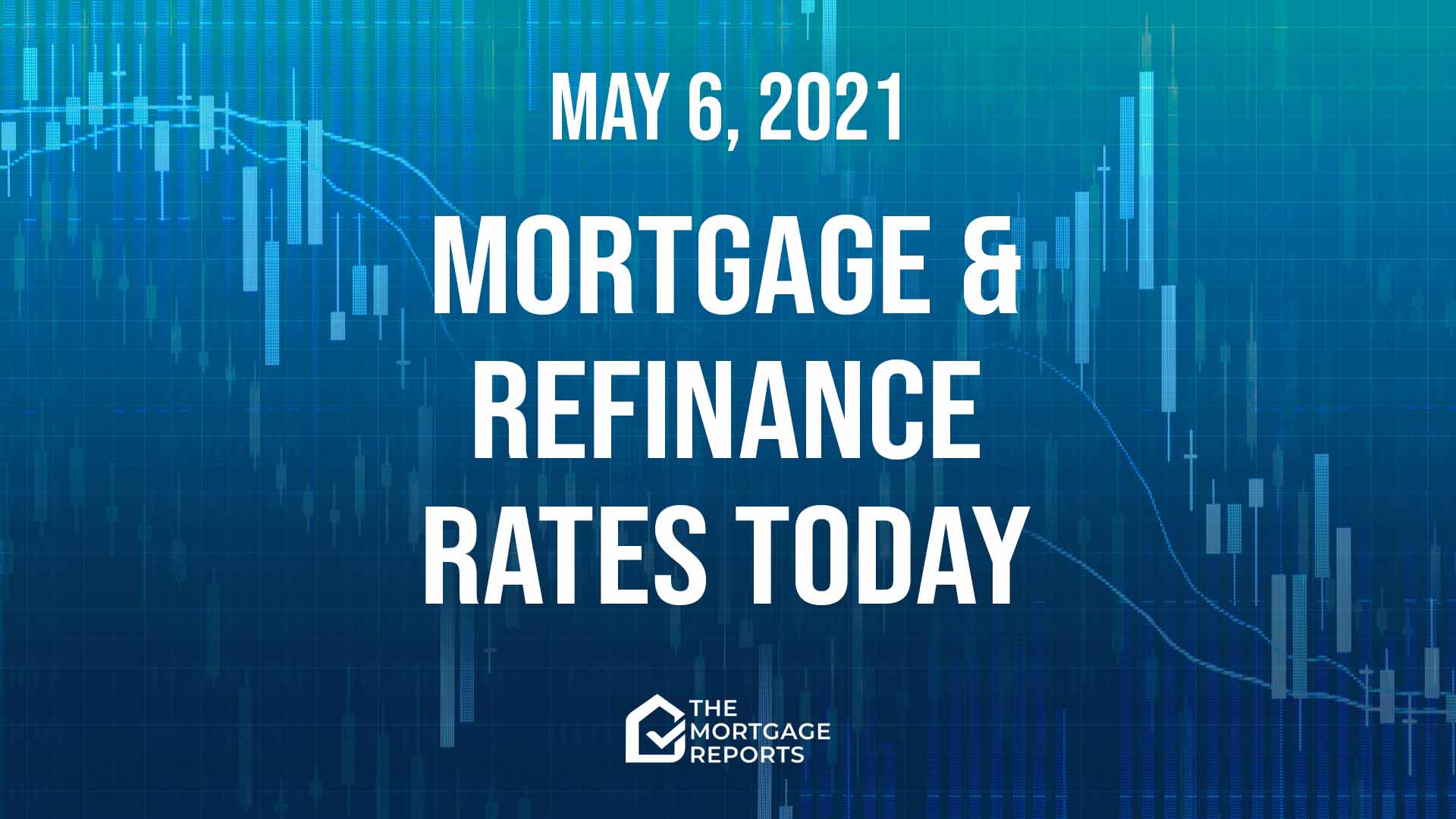
Today’s mortgage and refinance rates
Average mortgage rates inched higher yesterday. So we haven’t seen a fall since Monday. Of course, these rates are still very low. But the downward curve is clearly flattening.
Mortgage rates today look likely to be unchanged or slightly lower. That’s in spite of this morning’s weekly new claims for unemployment insurance tumbling by 92,000 to the lowest number since March 14, 2020. Such good news would normally push these rates higher.
Find and lock a low rate (May 6th, 2021)Current mortgage and refinance rates
| Program | Mortgage Rate | APR* | Change |
|---|---|---|---|
| Conventional 30 year fixed | |||
| Conventional 30 year fixed | 2.985% | 2.99% | Unchanged |
| Conventional 15 year fixed | |||
| Conventional 15 year fixed | 2.25% | 2.367% | +0.03% |
| Conventional 20 year fixed | |||
| Conventional 20 year fixed | 2.75% | 2.842% | Unchanged |
| Conventional 10 year fixed | |||
| Conventional 10 year fixed | 1.824% | 2.014% | Unchanged |
| 30 year fixed FHA | |||
| 30 year fixed FHA | 2.75% | 3.407% | Unchanged |
| 15 year fixed FHA | |||
| 15 year fixed FHA | 2.491% | 3.092% | Unchanged |
| 5 year ARM FHA | |||
| 5 year ARM FHA | 2.5% | 3.201% | +0.01% |
| 30 year fixed VA | |||
| 30 year fixed VA | 2.319% | 2.491% | -0.06% |
| 15 year fixed VA | |||
| 15 year fixed VA | 2.25% | 2.571% | Unchanged |
| 5 year ARM VA | |||
| 5 year ARM VA | 2.5% | 2.379% | +0.01% |
| Rates are provided by our partner network, and may not reflect the market. Your rate might be different. Click here for a personalized rate quote. See our rate assumptions here. | |||
COVID-19 mortgage updates: Mortgage lenders are changing rates and rules due to COVID-19. To see the latest on how coronavirus could impact your home loan, click here.
Should you lock a mortgage rate today?
Mortgage rates have been falling since early April. And you may prefer to float yours until they show signs of consistently rising. But check with your lender that you’re ready to lock the moment that happens.
And note that the worthwhile falls in early April have eased off considerably since the middle of that month. So you’re not gaining much by floating. But you are risking the effects of sudden, sharp rises. And I’d lock soon if I were in your position. Though maybe not today.
So my personal rate lock recommendations remain:
- LOCK if closing in 7 days
- LOCK if closing in 15 days
- LOCK if closing in 30 days
- LOCK if closing in 45 days
- LOCK if closing in 60 days
But I don’t claim perfect foresight. And your personal analysis could turn out to be as good as mine — or better. So you might choose to be guided by your instincts and your personal tolerance for risk.
Market data affecting today’s mortgage rates
Here’s a snapshot of the state of play this morning at about 9:50 a.m. (ET). The data, compared with roughly the same time yesterday, were:
- The yield on 10-year Treasurys fell to 1.58% from 1.60% (Good for mortgage rates.) More than any other market, mortgage rates normally tend to follow these particular Treasury bond yields, though less so recently
- Major stock indexes were mixed on opening. (Neutral for mortgage rates.) When investors are buying shares they’re often selling bonds, which pushes prices of those down and increases yields and mortgage rates. The opposite happens when indexes are lower
- Oil prices fell to $65.30 from $66.44 a barrel. (Good for mortgage rates*.) Energy prices play a large role in creating inflation and also point to future economic activity.
- Gold prices rose to $1,807 from $1,782 an ounce. (Good for mortgage rates*.) In general, it’s better for rates when gold rises, and worse when gold falls. Gold tends to rise when investors worry about the economy. And worried investors tend to push rates lower
- CNN Business Fear & Greed index — Fell to 49 from 52 out of 100. (Good for mortgage rates.) “Greedy” investors push bond prices down (and interest rates up) as they leave the bond market and move into stocks, while “fearful” investors do the opposite. So lower readings are better than higher ones
Caveats about markets and rates
Before the pandemic and the Federal Reserve’s interventions in the mortgage market, you could look at the above figures and make a pretty good guess about what would happen to mortgage rates that day. But that’s no longer the case. We still make daily calls. And are usually right. But our record for accuracy won’t achieve its former high levels until things settle down.
So use markets only as a rough guide. Because they have to be exceptionally strong or weak to rely on them. But, with that caveat, so far mortgage rates today look likely to edge a little lower or remain unchanged. Just be aware that intraday swings (when rates change direction during the day) are a common feature right now.
Find and lock a low rate (May 6th, 2021)
Important notes on today’s mortgage rates
Here are some things you need to know:
- Typically, mortgage rates go up when the economy’s doing well and down when it’s in trouble. But there are exceptions. Read ‘How mortgage rates are determined and why you should care
- Only “top-tier” borrowers (with stellar credit scores, big down payments and very healthy finances) get the ultralow mortgage rates you’ll see advertised
- Lenders vary. Yours may or may not follow the crowd when it comes to daily rate movements — though they all usually follow the wider trend over time
- When daily rate changes are small, some lenders will adjust closing costs and leave their rate cards the same
- Refinance rates are typically close to those for purchases. But some types of refinances are higher following a regulatory change
So there’s a lot going on here. And nobody can claim to know with certainty what’s going to happen to mortgage rates in coming hours, days, weeks, or months.
Are mortgage and refinance rates rising or falling?
Today and soon
Bond markets still seem to be in a state of indecision. Often, key ones are just inching up and down each day without any sense of direction.
And that goes for the one in which mortgage-backed securities (the bonds that actually determine mortgage rates) are traded, too. But it’s hard to understand why. A week ago, CNBC was observing:
April hiring was strong, and some economists expect more than 1 million jobs were added. The economy has been booming and job creation is also expected to run at a higher level for the next several months.
— CNBC, Job growth could surpass 1 million in April hiring boom as economy roars back, April 29, 2021
And that would normally send mortgage rates and bond yields shooting up. But those rates have barely budged since that was published.
Yes, investors have several pandemic-related fears, including the situation in India and the possibility of a resurgence here at home. But those seem flimsy compared with the solid economic data that screams that 2021 is going to be a boom year.
The jobs data that CNBC was predicting will be published tomorrow, in the official, monthly employment situation report. Might that be enough to push investors off the fence? Maybe. But you wouldn’t want to put your shirt on it.
Still, I remain convinced that higher rates are on their way. I just don’t know when.
For more background, check out our latest weekend edition of this report.
Recently
Over much of 2020, the overall trend for mortgage rates was clearly downward. And a new, weekly all-time low was set on 16 occasions last year, according to Freddie Mac.
The most recent weekly record low occurred on Jan. 7, when it stood at 2.65% for 30-year fixed-rate mortgages. But then the trend reversed and rates rose.
However, those rises were mostly replaced by falls in April, though those have moderated since the middle of the month. Freddie’s May 6 report puts that weekly average at 2.96% (with 0.6 fees and points), down from the previous week’s 2.98%.
Expert mortgage rate forecasts
Looking further ahead, Fannie Mae, Freddie Mac and the Mortgage Bankers Association (MBA) each has a team of economists dedicated to monitoring and forecasting what will happen to the economy, the housing sector and mortgage rates.
And here are their current rates forecasts for the remaining quarters of 2021 (Q2/21, Q3/21, Q4/21) and the first quarter of 2022 (Q1/22).
The numbers in the table below are for 30-year, fixed-rate mortgages. Freddie’s were updated on April 14, Fannie’s on April 12 and the MBA’s on April 22.
| Forecaster | Q2/21 | Q3/21 | Q4/21 | Q1/22 |
| Fannie Mae | 3.2% | 3.3% | 3.4% | 3.5% |
| Freddie Mac | 3.2% | 3.3% | 3.4% | 3.5% |
| MBA | 3.4% | 3.6% | 3.7% | 3.9% |
However, given so many unknowables, the current crop of forecasts might be even more speculative than usual.
Find your lowest rate today
Some lenders have been spooked by the pandemic. And they’re restricting their offerings to just the most vanilla-flavored mortgages and refinances.
But others remain brave. And you can still probably find the cash-out refinance, investment mortgage or jumbo loan you want. You just have to shop around more widely.
But, of course, you should be comparison shopping widely, no matter what sort of mortgage you want. As federal regulator the Consumer Financial Protection Bureau says:
Verify your new rate (May 6th, 2021)Shopping around for your mortgage has the potential to lead to real savings. It may not sound like much, but saving even a quarter of a point in interest on your mortgage saves you thousands of dollars over the life of your loan.



